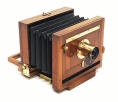Digital Camera Advantages

Not long ago serious photography with a digital camera wasn't an option. "VGA" cameras (307, 200 pixels) couldn't produce printable quality. The only serious digital option was to scan negatives.
In 2000 Casio came out with the first 3.3 megapixel camera, the QV3000EX, and everything changed. With three megapixels (three million pixels) or more you can make a 5 by 7 inch print that's at least as good as the same print made from a 35mm negative. Today even some relatively inexpensive digital cameras will give you files from which you can make prints up to 11 by14 inches or larger.
Some of the advantages of a digital camera
First, there's no film to buy. You store pictures on a small memory card, upload the images to your computer (or even print them directly from the card with a printer equipped to do that) and then erase the memory card and start over.
Second, once you've made a shot you can view it almost immediately. The viewer isn't large enough to let you see a lot of detail, but you can cull out the really bad shots on the spot and delete them from the memory card to make space for more, though I notice that nowadays with a 64 gigabyte card in my Olympus Pen-F I can shoot well over 2000 shots without running out of space..
Third, a digital camera can record color more accurately than film can, unless you're shooting film under very controlled conditions and can provide a light source that's exactly matched to the film. The key to good color is to make the light source match what the film's expecting. The color of a light source is measured in degrees Kelvin. Here are the approximate color temperatures of some light sources:
Candle flame – 1800 degrees K
Incandescent lighting (tungsten) – 3000 degrees K
White fluorescent lighting - 4000 degrees K
Clear day - outdoors - 5500 degrees K
Cloudy day - outdoors - 6500 degrees K
Outdoors in shadows, clear day - 7500 degrees K
Ordinary color film comes in two flavors: "daylight" and "tungsten." Daylight film expects a light source at about 5500 degrees K. Tungsten film expects a source at about 3000 degrees K. If you're shooting tungsten film in a room that has a few white fluorescent bulbs turned on, a few table lamps, and some daylight coming in through the picture windows, you have a problem with color balance.
Most cameras nowadays have an "Auto" white balance setting that actually works. Since the image is recorded with the help of a built-in computer, the camera can bias the color to the actual conditions. If the result leaves something to be desired you can adjust a digital picture's color balance on your computer much more easily than you can adjust the color balance of a print in a darkroom. This goes for digital pictures you've made with a scanner as well as for digital pictures you've made with a digital camera.
If you have a camera that can shoot "raw" images, meaning that the file records essentially everything the camera saw, you can adjust the white balance later, on your computer. This is by far the best option.
